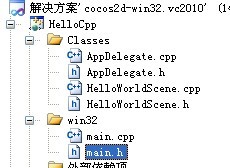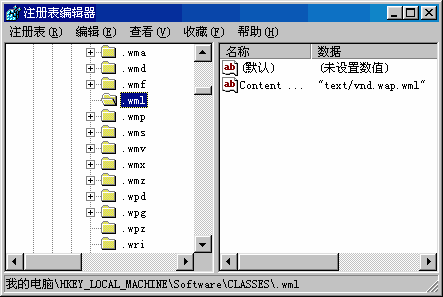main.cpp是win32平台的入口类,AppDelegate是应用真正的入口:
applicationDidFinishLaunching函数就是处理导演类和场景开始及资源的适配:
[cpp]
bool AppDelegate::applicationDidFinishLaunching() {
// initialize director
CCDirector* pDirector = CCDirector::sharedDirector();
CCEGLView* pEGLView = CCEGLView::sharedOpenGLView();
pDirector->setOpenGLView(pEGLView);
// Set the design resolution
pEGLView->setDesignResolutionSize(designResolutionSize.width, designResolutionSize.height, kResolutionNoBorder);
CCSize frameSize = pEGLView->getFrameSize();
// In this demo, we select resource according to the frame's height.
// If the resource size is different from design resolution size, you need to set contentScaleFactor.
// We use the ratio of resource's height to the height of design resolution,
// this can make sure that the resource's height could fit for the height of design resolution.
// if the frame's height is larger than the height of medium resource size, select large resource.
if (frameSize.height > mediumResource.size.height)
{
CCFileUtils::sharedFileUtils()->setResourceDirectory(largeResource.directory);
pDirector->setContentScaleFactor(largeResource.size.height/designResolutionSize.height);
}
// if the frame's height is larger than the height of small resource size, select medium resource.
else if (frameSize.height > smallResource.size.height)
{
CCFileUtils::sharedFileUtils()->setResourceDirectory(mediumResource.directory);
pDirector->setContentScaleFactor(mediumResource.size.height/designResolutionSize.height);
}
// if the frame's height is smaller than the height of medium resource size, select small resource.
else
{
CCFileUtils::sharedFileUtils()->setResourceDirectory(smallResource.directory);
pDirector->setContentScaleFactor(smallResource.size.height/designResolutionSize.height);
}
// turn on display FPS
pDirector->setDisplayStats(true);
// set FPS. the default value is 1.0/60 if you don't call this
pDirector->setAnimationInterval(1.0 / 60);
// create a scene. it's an autorelease object
CCScene *pScene = HelloWorld::scene();
// run
pDirector->runWithScene(pScene);
return true;
}
当程序进入后台时(不活跃)会调用applicationDidEnterBackground()函数,比如在玩游戏的时候一个电话打进来,程序就会进入后台
在这里可以释放一些资源,如:停止音乐播放,停止动画等
[cpp]
void AppDelegate::applicationDidEnterBackground() {
CCDirector::sharedDirector()->stopAnimation();
// if you use SimpleAudioEngine, it must be pause
// SimpleAudioEngine::sharedEngine()->pauseBackgroundMusic();
}
当程序在次活跃时,会调用applicationWillEnterForeground()函数,可以在这里恢复音乐的播放,动画等
[cpp]
// this function will be called when the app is active again
void AppDelegate::applicationWillEnterForeground() {
CCDirector::sharedDirector()->startAnimation();
// if you use SimpleAudioEngine, it must resume here
// SimpleAudioEngine::sharedEngine()->resumeBackgroundMusic();
}
HelloWorldScene场景类:
[cpp]
class HelloWorld : public cocos2d::CCLayer
{
public:
// Here's a difference. Method 'init' in cocos2d-x returns bool, instead of returning 'id' in cocos2d-iphone
virtual bool init();
// there's no 'id' in cpp, so we recommend returning the class instance pointer
static cocos2d::CCScene* scene();
// a selector callback
void menuCloseCallback(CCObject* pSender);
// implement the "static node()" method manually
CREATE_FUNC(HelloWorld);
};
关键的函数是init,主要是构建场景中的各种元素:如菜单项(CCMenuItem)、精灵(CCSprite)、文本(CCMenuLabel)等,每次创建元素后必须使用addChild()函数将其加入到场景中,addChild()有三个参数:1、要加入场景的对象的指针,2、绘制层的顺序,3、Tag标记。Tag标记方便用函数,getChildByTag(tag)函数取回对象,以便使用,HelloWorld的init函数必须先调用父类的init()函数:
[cpp]
bool HelloWorld::init()
{
//////////////////////////////
// 1. super init first
if ( !CCLayer::init() )
{
return false;
}
CCSize visibleSize = CCDirector::sharedDirector()->getVisibleSize();
CCPoint origin = CCDirector::sharedDirector()->getVisibleOrigin();
/////////////////////////////
// 2. add a menu item with "X" image, which is clicked to quit the program
// you may modify it.
// add a "close" icon to exit the progress. it's an autorelease object
CCMenuItemImage *pCloseItem = CCMenuItemImage::create(
"CloseNormal.png",







